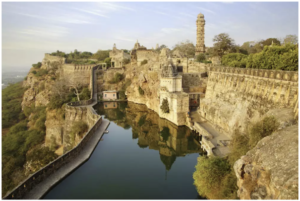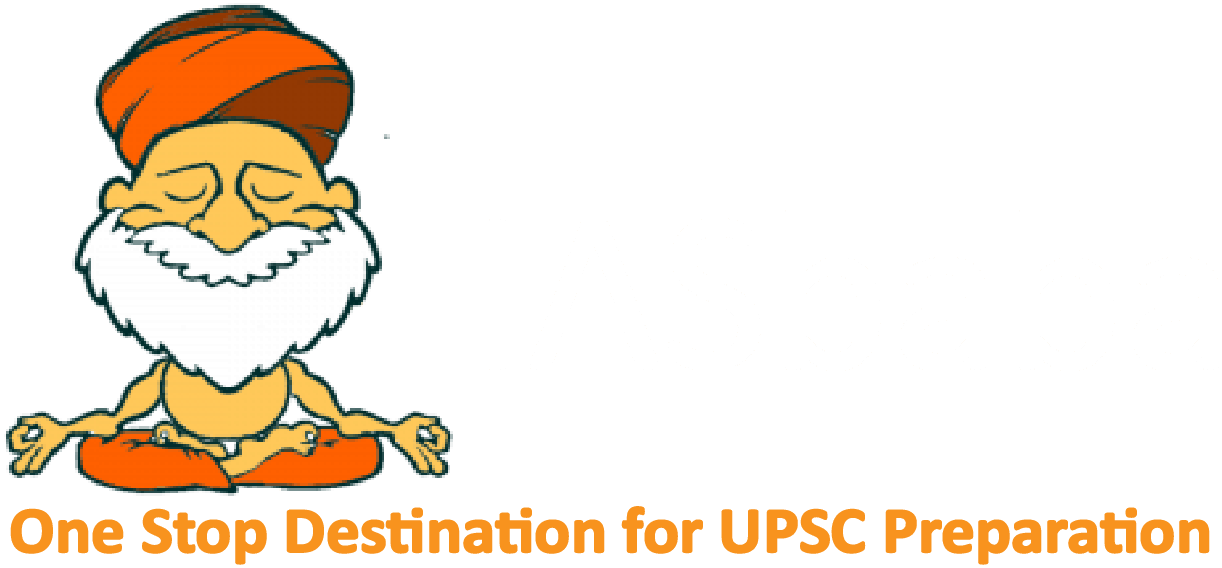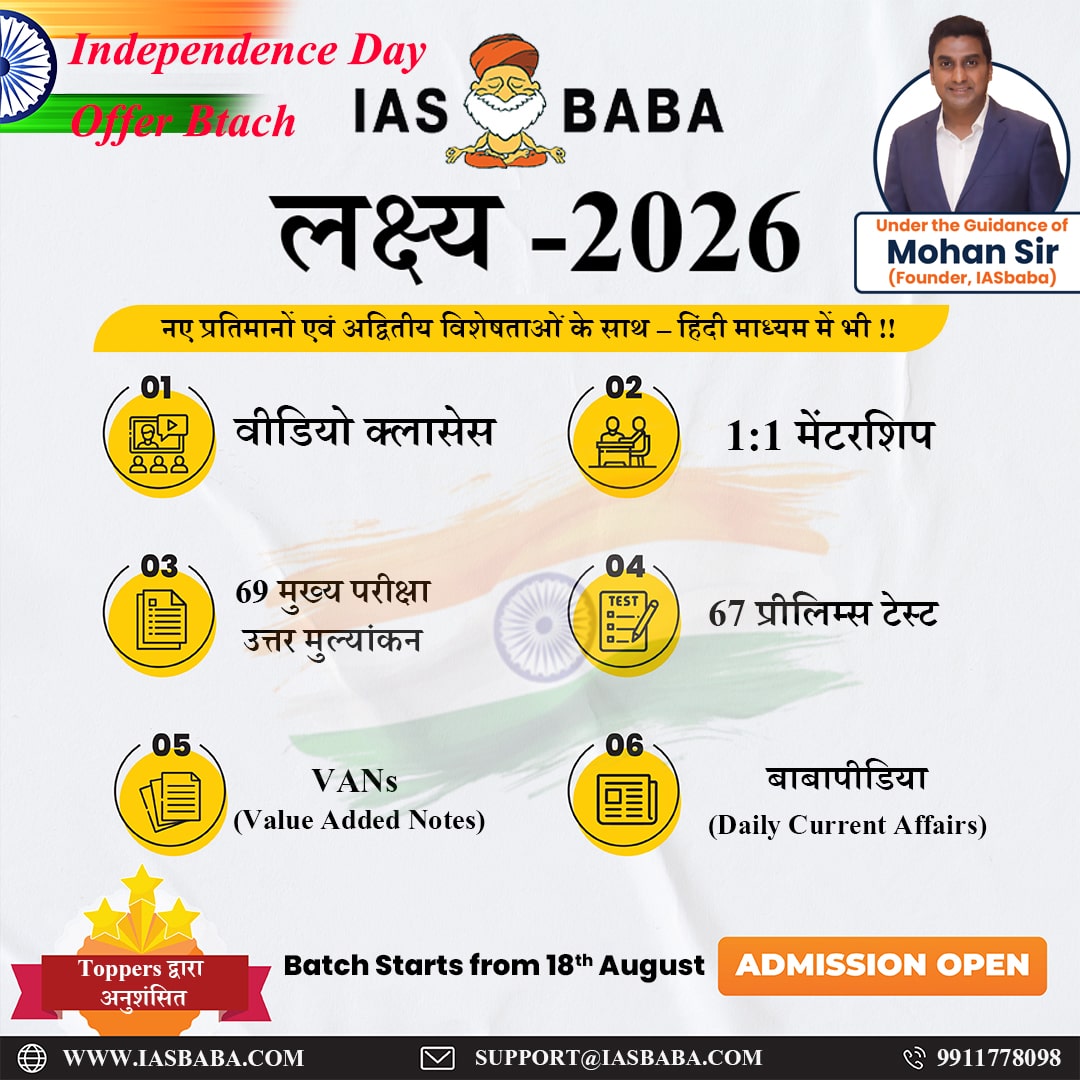IASbaba's Daily Current Affairs Analysis
Archives
(PRELIMS & MAINS Focus)
Category: ECONOMY
Context: The Reserve Bank of India’s (RBI’s) six-member Monetary Policy Committee (MPC) on April 9th decided to cut the repo rate by 25 basis points to 6%.
Decoding the context: The rate setting panel also changed the monetary policy stance from “neutral” to “accommodative”, signaling further reductions in the repo rate in the near future.
Learning Corner:
- The repo rate is the interest rate at which a central bank (Reserve Bank of India – RBI), lends money to commercial banks for a short period.
- The term “repo” stands for repurchase agreement, which means that banks borrow funds from the RBI by selling securities (usually government bonds) with an agreement to repurchase them at a later date, typically overnight or within a few days. The repo rate essentially represents the cost of borrowing for these banks.
- When the RBI lowers the repo rate (like reducing it from 6.25% to 6% on April 9, 2025), it becomes cheaper for banks to borrow money. This typically encourages banks to lend more to businesses and individuals, boosting economic activity, increasing money supply, and potentially stimulating growth
About Reverse Repo
- The reverse repo rate is the interest rate at which the RBI borrows money from commercial banks. It’s essentially the opposite of the repo rate. When banks deposit their excess funds with the RBI, they earn interest at the reverse repo rate. This rate is typically lower than the repo rate and helps the RBI absorb liquidity from the economy.
- If the RBI wants to reduce the amount of money circulating (to control inflation, for example), it might increase the reverse repo rate, incentivizing banks to park more funds with it instead of lending them out.
Source : Indian Express
Category: POLITY
Context: In a push for data driven governance, the Department of Panchayati Raj has come up with the first ever Panchayat Advancement Index (PAI).
Decoding the context: There are 2.5 lakh gram panchayats in the country. Out of these, data of around 2.16 lakh gram panchayats from 29 States have been assessed.
Learning Corner:
- The Panchayat Advancement Index (PAI) is a comprehensive, multi-domain, and multi-sectoral tool introduced by the Ministry of Panchayati Raj in India to assess the holistic development, performance, and progress of Gram Panchayats across the country.
- The PAI reflects India’s commitment to achieving the SDG 2030 Agenda through participatory, bottom-up development.
- The first baseline report, released for FY 2022-23, analyzed data from 2,16,285 panchayats with validated inputs.
Purpose of PAI :
- Measures the overall well-being and development status of local communities under a panchayat’s jurisdiction.
- Identifies development gaps and supports evidence-based planning and policy-making at the grassroots level.
- Encourages panchayats to adopt best practices and set local targets to enhance their performance.
Indicators:
- Panchayat Advancement Index (PAI) is a composite Index & has been compiled based on 435 unique local Indicators (331 mandatory & 104 optional) consisting of 566 unique data points across 9 themes of LSDGs (Localization of Sustainable Development Goals) aligned with National Indicator Framework (NIF) of the Ministry of Statistics and Programme Implementation (MoSPI).
- Nine Themes of Localized SDGs:
- Poverty-Free and Enhanced Livelihoods Panchayat
- Healthy Panchayat
- Child-Friendly Panchayat
- Water-Sufficient Panchayat
- Clean and Green Panchayat
- Self-Sufficient Infrastructure in Panchayat
- Socially Just and Socially Secured Panchayat
- Panchayat with Good Governance
- Women-Friendly Panchayat
- Based on the PAI scores & thematic Scores achieved by different Gram Panchayats, these GPs are grouped into one of the five categories
- Achiever: 90+ score (none achieved this in 2022-23)
- Front Runner: 75 to <90 (e.g., 699 panchayats, 0.3%)
- Performer: 60 to <75 (e.g., 77,298 panchayats, 35.8%)
- Aspirant: 40 to <60 (e.g., 1,32,392 panchayats, 61.2%)
- Beginner: <40 (e.g., 5,896 panchayats, 2.7%)
Source : The Hindu
Category: ECONOMY
Context: The S&P 500 —- a stock market index that tracks the performance of 500 of the largest publicly traded companies in the US — on Monday briefly entered bear market territory for the first time since 2022.
Decoding the context: A bear market (or for that matter, all types of market decline) takes place when investors are more motivated to sell than to buy stocks.
Learning Corner:
- A bear market refers to a condition in which a stock index declines by at least 20% from its most recent peak value. This designation lacks an official or standardized determination and serves primarily as an informal term to succinctly indicate a significant downturn in the stock index.
- A bear market is the opposite of a bull market, which refers to when a stock index has increased at least 20% from its recent low. Note that a bear market is different from a market correction which occurs when there is a decline of at least 10% or more.
Why does a bear market occur?
- There could be a host of different reasons. These include a weak economy, the anticipation of an economic slowdown, or investor sentiment that the market is too hot and prices too high. Events that are not purely economic — such as wars, oil supply shocks, etc — can also spook investors, leading to a dip in the market.
- A bear market often precedes a recession — a slowdown in economic output and is usually defined as at least two consecutive quarters of decline in gross domestic product (GDP). However, this is not always the case.
- The Indian stock market has also experienced bear markets over the years. One of the worst bear markets occurred during the 2008 global financial crisis. Between September 8, 2008, and November 6, 2008, the Nifty 50 index had dropped over 35%.
Source : Indian Express
Category: GEOGRAPHY
Context: The Thar Desert in India saw a striking 38 per cent rise in greening annually over the last two decades, driven by a significant increase in monsoon rainfall and agricultural expansion, a new study showed.
Decoding the context: In fact, Thar was the only desert in the world with the highest concurrent increase in population, precipitation and vegetation during the last few decades, scientists from IIT Gandhinagar and Bay Area Environmental Research Institute, NASA Research Park in the US established.
Learning Corner:
- Location: The Thar Desert is located in northwestern India, primarily in Rajasthan (over 60% of its Indian extent), with parts extending into Gujarat, Haryana, and Punjab. It also spills into eastern Pakistan (Sindh and Punjab provinces).
- Area: Covers approximately 2,00,000 sq. km in India, making it the world’s 17th-largest desert and the 9th-largest hot subtropical desert.
- Boundaries:
- North: Punjab plains
- East: Aravalli Range
- South: Rann of Kutch
- West: Indus River valley in Pakistan
Physical Features
- Topography: Characterized by vast stretches of sand dunes (longitudinal and transverse), rocky outcrops, salt lakes, and sparse vegetation. The terrain includes shifting dunes (locally called dhrian) and fixed dunes stabilized by vegetation.
- Rivers: The Luni River is the only significant seasonal river in the region, flowing southwest into the Rann of Kutch. Most other water bodies are ephemeral.
- Climate: Arid with extreme temperatures—summers exceeding 45°C and winters dropping to near 0°C. Annual rainfall is low (100-500 mm), mostly during the southwest monsoon, with high variability.
- Soil: Predominantly sandy and saline, with low organic content, making it less fertile except in areas with irrigation.
Ecological Significance
- Despite its aridity, the Thar supports unique flora and fauna:
- Flora: Xerophytic plants like khejri (Prosopis cineraria), rohida, and cacti.
- Fauna: Great Indian Bustard (critically endangered), chinkara, desert fox, and blackbuck. Migratory birds like flamingos visit salt lakes (e.g., Sambhar Lake).
- National Park: The Desert National Park in Jaisalmer and Barmer districts is a biodiversity hotspot and a conservation area for the Great Indian Bustard.
Socio-Economic Aspects
- Population: Sparsely populated (around 83 persons/sq. km) with communities like Rajputs, Jats, and nomadic tribes (e.g., Banjaras). Livestock rearing (camels, goats, sheep) is a primary livelihood.
- Agriculture: Limited due to aridity, but irrigation projects like the Indira Gandhi Canal (world’s longest canal, 649 km) have transformed parts of Sri Ganganagar, Bikaner, and Jaisalmer into fertile zones for wheat, cotton, and mustard.
- Economy: Mineral resources (gypsum, limestone, feldspar) and renewable energy (solar and wind) are emerging sectors. Bikaner and Jodhpur are hubs for solar projects.
- Culture: Rich heritage with folk music (e.g., Manganiyar tradition), handicrafts, and tourism (e.g., Jaisalmer Fort, camel safaris).
Source : Down To Earth
Category: HISTORY
Context: The Rajasthan government informed the Supreme Court that it is “actively considering” a complete ban on mining activities up to 10 kilometres from the outer boundary of the historic Chittorgarh Fort, seeking time to place on record its affidavit.
Decoding the context: The matter arises from a long-standing legal battle between Birla Corporation Limited and the State of Rajasthan and others, regarding mining operations near the Fort, a UNESCO World Heritage site.
Learning Corner:

- Geographical Position: Situated in Chittorgarh (often spelled Chittor Fort), Rajasthan, atop a 180-meter-high hill overlooking the Berach River (a tributary of the Banas River), approximately 112 km from Udaipur.
- Area: Sprawls over 280 hectares (692 acres), making it one of the largest forts in India and a UNESCO World Heritage Site (listed in 2013 under “Hill Forts of Rajasthan”).
- Origins: Traditionally dated to the 7th century AD, attributed to Chitrangada Mori of the Mori Kingdom.
- Rajput Rule: Became the capital of the Mewar kingdom under the Sisodia Rajputs from the 8th century onward. The fort symbolizes Rajput resistance, honor, and sacrifice.
Key Events:
- First Siege (1303): Alauddin Khalji of the Delhi Sultanate attacked. This led to jauhar (mass self-immolation) by women to avoid capture.
- Second Siege (1535): Bahadur Shah of Gujarat besieged the fort, leading to another jauhar led by Rani Karnavati.
- Third Siege (1567-68): Mughal Emperor Akbar captured the fort, marking the decline of Mewar’s dominance. The fort was abandoned as a capital after this—Udaipur became the new capital.
Architectural Features
- Design: A classic example of a hill fort with concentric layers of defense—seven massive gates (e.g., Padan Pol, Bhairon Pol, Ram Pol), thick stone walls, and natural elevation.
- Monuments Inside:
- Vijay Stambh (Tower of Victory): Built by Rana Kumbha in 1448 to commemorate his victory over Mahmud Khalji of Malwa. A nine-story, 37-meter-high tower adorned with Jain and Hindu carvings.
- Kirti Stambh (Tower of Fame): A 22-meter-high, 12th-century Jain tower dedicated to Adinath, showcasing intricate sculptures.
- Rana Kumbha Palace: The oldest structure, partially in ruins, where Rani Padmini is said to have performed jauhar.
- Padmini Palace: A picturesque structure near a lotus pool, linked to the legend of Padmini.
- Temples: Over 20 temples, including the Kumbha Shyam Temple (Vishnu), Meera Temple (dedicated to poet-saint Meerabai), and Kalika Mata Temple (originally a Sun temple from the 8th century, it was later dedicated to Goddess Kali).
- Water Bodies: 22 surviving reservoirs (e.g., Gaumukh Kund) out of 84 originally built, showcasing advanced water harvesting for self-sufficiency.
- UNESCO Status: Recognized in 2013 as part of the Hill Forts of Rajasthan (alongside Kumbhalgarh, Ranthambore, etc.) for its architectural grandeur and historical legacy.
Source : Indian Express
Practice MCQs
Q1.
Consider the following statements regarding a Bear Market:
- A bear market is characterized by a decline of at least 100% in stock prices from recent highs.
- It generally reflects negative investor sentiment and a pessimistic economic outlook.
- A bear market is always accompanied by a recession.
- A bear market is the opposite of a bull market.
Which of the statements given above is/are correct?
A. 1 and 2 only
B. 2 and 4 only
C. 1, 2 and 3 only
D. 1, 2, 3 and 4
Q2.
With reference to the Thar Desert, consider the following statements:
- The Luni River is the only major river flowing through the Thar Desert and it ultimately drains into the Arabian Sea.
- The Desert National Park located in the Thar region is a critical habitat for the Great Indian Bustard.
- The Indira Gandhi Canal has contributed significantly to the greening of parts of the desert, especially in Rajasthan.
- The Aravalli Range forms the western boundary of the Thar Desert.
Which of the statements given above is/are correct?
A. 1 and 4 only
B. 2 and 3 only
C. 1, 2 and 3 only
D. 1, 2, 3 and 4
Q3.
With reference to the Chittorgarh Fort, consider the following statements:
- The fort served as the capital of the Mewar kingdom under the Sisodia Rajputs.
- The Kirti Stambh in the fort was built by Rana Kumbha to commemorate his victory over the Malwa Sultan.
- Chittorgarh Fort is one of the UNESCO World Heritage Sites listed under “Hill Forts of Rajasthan.”
- The fort witnessed three major sieges, the last one being by Emperor Akbar.
Which of the statements given above is/are correct?
A. 1, 3 and 4 only
B. 1 and 2 only
C. 2 and 4 only
D. 1, 2, 3 and 4
Comment the answers to the above questions in the comment section below!!
ANSWERS FOR ’ Today’s – Daily Practice MCQs’ will be updated along with tomorrow’s Daily Current Affairs
ANSWERS FOR 8th April – Daily Practice MCQs
Q.1) – b
Q.2) – b
Q.3) – b













